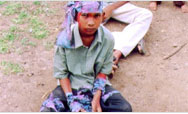 |
|
 |
 |
|
 |
 |
 |
| USAID Information:
External Links:
|
|
 |
 |
|
Pakistan
The Development Challenge: Pakistan poses one of the Agency's most daunting development challenges. A country beset since independence with widespread poverty and weak governance structures; it now faces additional burdens related to the war on terrorism in Afghanistan.
 |
|
Please note: All documents are in pdf format |
Pakistan's macroeconomic picture has stabilized and grown measurably stronger since the early 1990s. Since 1999, President Musharraf has mobilized strong support from the World Bank, the Asian Development Bank, and the Paris Group and succeeded in significantly redressing much of the economic management picture, particularly its debt burden. The Prime Minister has publicly pledged to continue economic, social, and political reforms. Challenges remain however, despite strong macro-economic performance; poverty has risen during the last five years. Approximately 33% of Pakistan's 148 million people live in poverty in urban and rural areas and in all four provinces. Social sector spending in education and health, though increased slightly in 2002, still lags far behind appropriate levels, largely due to military expenditures.
The United States has a compelling national interest in Pakistan's success as a nation. U.S. Government (USG) efforts will focus on maintaining political stability throughout the country and region, assisting the Government of Pakistan (GOP) in the international campaign against terrorism, strengthening Pakistan as a development partner, addressing fundamental economic and social weaknesses, and launching the country on a stable developmental course. The government is making efforts to address Pakistan's social inequities, devolve political and economic authority to the provinces, and raise basic health and education standards.
The USAID Program: USAID returned to Pakistan in July 2002 after a seven-year hiatus, as part of the USG's commitment to help Pakistan in the fight against global terrorism. USAID operations are severely constrained by the security situation in Pakistan. Staff is very limited and office space is very tight. USAID has adapted to this situation in several ways. It is staying focused on four sectors, outsourcing some USAID functions to private firms, using Pakistani organizations as much as possible to implement its programs and partnering with NGOs and other donors wherever possible.
The program is focused on four sectors, namely, education, health, democracy/governance and economic growth. It concentrates on institutional building and human development to improve the quality of and access to basic education programs; delivery of health services (including reproductive health, HIV/AIDS, tuberculosis and polio) to women, children, and vulnerable groups; availability of credit to boost rural incomes; and elected official and civil society collaboration on resolve social and economic issues. The cross-cutting theme, which cannot be addressed in isolation, is developing human resources. This includes promoting the participation of communities and citizens, encouraging women and development, improving NGO capacity, and increasing private sector involvement in all aspects at social and economic development. USAID has signed four grant agreements with the Government of Pakistan that total more than $300 million. These include education ($100 million); health ($115 million); democracy/governance ($38 million); and economic growth ($53 million). All USAID funds are grant assistance.
Other Program Elements: In addition to its programs in basic education, democracy, economic growth, and health, USAID provided a cash transfer of $600,000,000 in FY 2002 to the GOP from funds made available under the Emergency Supplemental Appropriations Act (P.L. 107-38). USAID also provided $188,000,000 to the GOP in FY 2003 to buy down $1 billion of Pakistan's international debt. In FY 2004, USAID plans to provide another $200,000,000 for debt relief.
Other Donors: Foreign assistance to Pakistan, from multilateral and bilateral bodies and international financial institutions (IFIs) shows an upward trend. Multilateral aid comes from United Nations and the European Union. The UN aid covers sectors ranging from governance and gender development to health, education and environment. The EU concentrates on the health and education sectors. The top three IFIs supporting Pakistan are the World Bank, Asian Development Bank and International Finance Corporation. Their areas of focus are the governance, infrastructure and energy sectors. The top three bilateral donors are Japan, U.K., and Germany. The focus areas of the top ten bilateral donors are the financial sector, energy and governance.
In the social sector, donor coordination is strong, and donors work together to develop joint sector concept papers in certain areas. Each donor subsequently selects a portion of the portfolio for funding. Key partners are the U.K.'s Department for International Development for health and legislative strengthening; the Asian Development Bank for microfinance and access to justice; and the Canadian International Development Agency for education.
Back to Top ^
|


